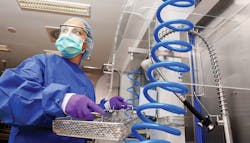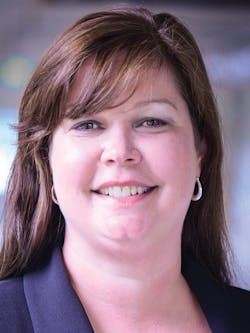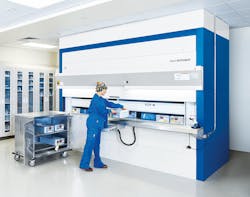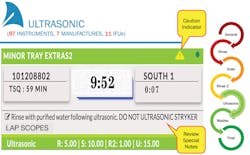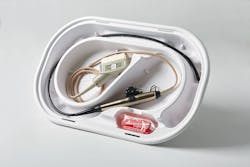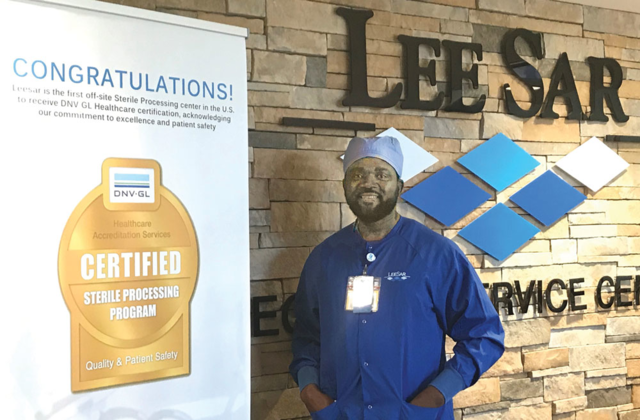Onsite versus offsite reprocessing
It has certainly been an interesting time for central sterile/sterile processing departments (CS/SPD) with surgical volumes drastically reduced due to a hold on elective procedures. In some cases, healthcare organizations have laid off or furloughed their CS/SPD professionals, and in other cases, they have reallocated department staff to other tasks related to the pandemic, such as reprocessing of N95 respirators.
When the dust from the COVID-19 pandemic settles down, health systems and hospitals will likely take a step back to evaluate their processes to understand what works and what doesn’t work both during times of “business as usual” and during infectious disease outbreaks as we are experiencing right now.
One area that healthcare organizations might evaluate in the months ahead is whether onsite reprocessing of surgical instruments still fits their needs or if a move to offsite reprocessing is the way to go.
In this article, we speak with industry experts for their insights on the pros and cons of onsite versus offsite reprocessing, key considerations when considering a move offsite, and best practices for ensuring quality and safety when reprocessing is performed outside the four walls of a hospital or other healthcare facility. We also present their thoughts on whether the COVID-19 pandemic presents any specific risks or opportunities when taking an offsite approach.
Onsite, centralized or offsite reprocessing
Healthcare organizations have a few options from which to choose when exploring a new sterile processing strategy. There is the traditional method of using an in-house CS/SPD where the sterile processing team and operations reside under the same roof as the operating rooms (OR) and other clinical department customers.
For health systems with more than one facility performing procedures that require the reprocessing of instruments, another option is to centralize CS/SPD operations within one location, such as the main hospital campus. The central CS/SPD receives instruments after use from the other facilities, reprocesses them and then transports them back sterile for reuse.
“The health system performed environment of care (EOC) audits and found its main campus CS/SPD scored highest when it came to factors critical to reprocessing success and safety, such as the accuracy of sterilization records. The main campus also had the largest CS/SPD space, and was centrally located in relation to the health system’s seven other hospitals, with the furthest facility two hours away.”
A third option is to move CS/SPD operations to an offsite location that is either owned and operated by the health system or a third party. In this scenario, after instruments are used in a case, they are transported offsite to a centralized location where CS/SPD professionals (either employed by the health system or a third-party service supplier) reprocess them and then send them back to their respective facilities.
“Because elective surgeries have been postponed due to COVID-19, many hospitals have laid off or furloughed their CS/SPD team members. In the coming months as hospitals begin performing these procedures again, they will experience a surge in volume, which means a correlating demand for sterile processing,” said Cox. “Our offsite facilities have the capability to supplement a facility’s CS/SPD operations as they ramp back up. Another option is our Mobile SPDs, which offer an onsite solution for supplemental support.”
“There are guidelines that must be followed for transporting the sterile instruments back to the healthcare facilities. The guidelines for processing and transporting the instruments have not changed with the COVID-19 pandemic. The guidelines should be adhered to at all times. There is no published literature regarding how long the COVID-19 virus can remain on hard surfaces at this time, therefore, caution should be taken with all containers that enter into the healthcare facility. If deemed necessary, hard surfaces and plastic containers entering healthcare facilities may be disinfected with products such as Ruhof’s Biocide as a precautionary measure.”
Onsite or offsite? Key considerations
We asked industry experts to offer their advice to healthcare organizations that are considering a move to offsite reprocessing, including key considerations to take into account when weighing the pros and cons of both approaches. We also asked specifically for their thoughts on whether the COVID-19 pandemic is presenting any particular challenges to reprocessing surgical instruments offsite.
“On the other hand, onsite reprocessing benefits include the ability to rely on internal resources, not having to transport instruments to/from an offsite facility and greater control over your CS/SPD processes,” VanHee added. “A key consideration is turnaround times with onsite versus offsite reprocessing. For example, I would think hospitals in areas hit hard by COVID-19 are tasked with reprocessing a high volume of laryngoscope blades for tracheal intubation and turnaround times are critical.”
Do your homework
Lane refers to AAMI ST79 as a “great resource” noting how section 6 covers the “handling, collection, and transport of contaminated items” with 6.5.6 and 6.5.7 going into great detail regarding the transportation between buildings and offsite transportation.
Lane said there should not be any additional dangers in transporting instruments offsite during the current pandemic, as long as healthcare facilities adhere to the Centers for Disease Control (CDC) Standard Precautions (2007) for all contaminated items that they receive, this includes practicing proper hand hygiene and use of personal protective equipment (PPE).
“However, in reality COVID-19 likely has some impact simply because it has instilled fear in some due to all of the unknowns surrounding the virus,” Lane added. “Mitigating the fear in people is tough; however, positive supporting attitudes from leadership of SPD; as well as hospital leadership will go a long way.”
Don’t skimp on the pre-planning
Kevin Anderson, BSN, RN, CNOR, CRCST, CHL, CIS, CER, Clinical Education Coordinator, Healthmark, says one of the drivers behind consolidating reprocessing, either within a health system or out to a third-party provider, is the opportunity to standardize and streamline CS/SPD processes. Before making the transition, a healthcare organization should examine current processes and practices within different sites to determine what does/doesn’t work, and then carry best practices to its new reprocessing model.
“In many cases the CS/SPDs within the health system’s hospitals will have their own standard operating procedures (SOP), key performance indicators (KPI), and processes related to education, training and documentation,” said Anderson. “Some health systems are so large they span the country so it is no surprise that processes are disjointed. Transitioning to a central CS/SPD, whether on or offsite, provides the opportunity to standardize and streamline operations for greater efficiency, efficacy and cost savings.”
“This team should evaluate current procedures being performed and what procedures they anticipate will be performed in another year or the next five years,” said Rojo. “In the case where the healthcare organization plans on leveraging current CS/SPD staff members to facilitate consolidated reprocessing they must understand whether these individuals are qualified, what training must take place and how long that training will take. If current capabilities are inadequate, infection prevention can help justify the need for more FTEs, equipment and instruments.”
Evaluate potential reprocessing partners
“There is inherent danger in transporting instruments offsite and receiving them back from an onsite location, given the possibility of contamination,” said Thording. “Healthcare organizations must mitigate this risk by carefully selecting their reprocessing partner, and by weighing the risk against the advantages of stronger supplies. In selecting a reprocessing partner, examine the instrument journey and identify points of weakness. Additionally, look at quality systems as well as the source and nature of the authorization granted to reprocess instruments during the coronavirus crisis.”
Reprocessing safety strategies
Lars Thording, PhD, VP of Marketing & Public Affairs at Innovative Health, explains the three different types of offsite reprocessing, and different safety strategies required for each:
- Reusable device reprocessing, such as endoscope reprocessing: These are devices designed and labeled to be reused, so they are usually very durable. Many companies can offer this service, with limited FDA oversight. For this type of offsite reprocessing, ensure that facilities have a decent quality control system, that they are FDA regulated, and – importantly – that they have an effective means of counting how many times devices have been reprocessed. If at all possible, visit the facility./li>
- Single-use device reprocessing: This is an entirely different activity, as single-use device reprocessors must have FDA clearance for each device they offer to reprocess. This industry has very few suppliers, and they are all tightly FDA regulated and have advanced quality systems. Collection and transportation to the reprocessing plant is managed by highly trained technicians who use biohazard packaging – and devices are returned to the hospital in sterile packaging. Ensure that your reprocessor is a member of the Association of Medical Device Manufacturers (AMDR).
- Reprocessing under FDA Emergency Use Authorization (EUA): During the COVID-19 crisis, the FDA has issued EUAs to companies to reprocess single-use devices (N95 respirators, for example). Using an emergency authorization, companies do not have to have quality systems in place and the standards for achieving an EUA are far below FDA’s usual clearance process. It is critically important that hospitals carefully evaluate transportation, reprocessing, sterilization and return shipping processes.
Assess your procedures and map your processes
Whether reprocessing is performed on or offsite, successful and safe CS/SPD operations require the team to carefully assess their quality procedures and map out their processes to ensure they adhere to industry guidelines (e.g. AAMI, AORN).
Anthony Shimkin, MBA, MS, MA, Chief Marketing Officer, ReadySet Surgical, recommends that healthcare organizations leverage quality procedures, documentation, teamwork and technology where applicable to prevent contamination of processed instruments and devices offsite.
“Procedures should be regularly reviewed and match industry standards to ensure that chain of custody processes are adhered to, especially at offsite locations,” said Shimkin. “Documentation that supports compliance with sterile procedures is critical as instruments and devices arrive and depart offsite facilities. Checklists, for instance, are used effectively in other industries like airlines for quality control and to mitigate risk.”
“How your facility operates, how reprocessing is performed, how instrumentation is transported to and from; every step should be carefully considered and designed in concert with your clinical team,” said Turner. “Engaging your clinical experts to oversee internal operations and advise on the needs within the hospital setting will go a long way to ensuring full-cycle continuity and clarity.”
Consider your containment solutions
As David Phillips, Marketing Manager, Hänel Storage Systems, points out, threats of possible contamination are everywhere. Therefore, he says the only way to maintain sterility offsite is to keep supplies and instruments within complete containment, so they are protected from every direction and contaminants cannot reach them. Phillips recommends use of an automated vertical carousel, which is a six-sized box that ensures that sterilized items remain sterile.
“Supplies and instruments can’t be touched by human hands or by airborne droplets that contain germs,” said Phillips. “Tiny droplets in a cough or sneeze can travel as far as six feet and land on nearby surfaces, but there’s no danger of these droplets landing on sterile supplies while they are protected inside a sealed carousel. The chances of contamination to sterile product enclosed within is dramatically reduced, which decreases the cost of replacing contaminated product.”
When asked specifically about containment considerations during the current COVID-19 pandemic, Phillips states:
“There are inherent dangers to transporting anything offsite. While in transit to the hospital, sterilized items can become compromised during a traffic accident just as easily as they can be exposed to COVID-19. That being said, the best way to mitigate any dangers en route is to package sterilized items inside containers that have themselves been sterilized, and then package everything inside yet another protective container. This must be done using only the staff that are authorized to do so, with a corresponding team at the hospital. If the hospital is unable to coordinate the transportation internally, then the work should be done through a certified transport service, so that there are fingerprints of each transaction at all times.”
Evaluate methods of transport
Industry experts agree that transport is one of the most challenging aspects of offsite reprocessing, whether healthcare organizations are operating under business as usual, or during a crisis situation as we are currently facing with COVID-19.
“Develop policies and procedures in accordance to regulatory agencies and standards that limit exposure of instruments to dust, moisture, sunlight, temperature and humidity fluctuations as these elements increase the potential for contamination,” said Coss.
Coss stresses the importance of providing a comprehensive training program for all transportation employees that includes proper handling of contaminated and sterile items.
Turner acknowledges that the highest risk for contamination of instruments exists during transport because it is an “inherently uncontrolled environment.” Whether a healthcare organization outsources its transport needs or keeps them in-house, Turner says it is vital to stay on top of regulations and eliminate any blind spots to regulatory compliance.
“The danger of contamination has always existed, but COVID-19 has sharpened our focus to it,” said Turner. “The mitigation mechanisms remain the same: Contain dirty items, maintain clean areas and follow protocols meticulously. This pandemic should encourage us all to double down on those efforts and monitor adherence to them closely.”
With regards to COVID-19, Shimkin says lack of knowledge around the virus and its ability to survive on surfaces makes it a particular concern when transporting instruments.
“One key challenge is there is still so much we don’t know about the virus,” said Shimkin. “A New England Journal of Medicine study found that COVID-19 can live on surfaces for up to three days. The CDC found RNA from COVID-19 on a cruise ship 17 days after passengers departed. The CDC also found that the virus can travel 13 feet through the air and is transported on shoes.”
“To mitigate COVID-19 risks, healthcare organizations should rely on updated guidance and adapt policies and procedures accordingly,” Shimkin added. “Staff should also be given adequate resources including protective equipment, as well as time to manage any increased demand for supplies and devices while reducing the chance for errors.”
To address the potential risks of COVID-19 when engaging in offsite instrument reprocessing, Coss recommends healthcare facilities conduct a risk assessment with their infection prevention teams, follow policies and procedures for transport of soiled instrumentation, follow standard precautions, maintain U.S. Department of Transportation (DOT) rules and regulations for transportation of soiled instrumentation, and create the most direct path to get the instrumentation from point of use to processing.
“The possible danger in transporting instruments with COVID-19 is the novel virus can live in the air for several hours and on some surfaces for as long as two to three days,” said Coss. “Careful handing and care of any soiled equipment must be meticulously followed to avoid risk of infection.”
Another potential issue related to transport is lost or damaged instruments. Mike Cowan, Inside Sales Specialist, Scanlan International, recommends that healthcare facilities utilize the same policies and procedures they would have if they were processing instruments and devices onsite.
“As with any process which is new, there is a danger in not following policies and procedures,” said Cowan. “There is also the possibility that things can get lost or damaged in transport. Keep everything organized and use communication tools to accurately label and list what is in your sets/equipment and how they should be processed. Scanlan International’s Easy-Tag can be a great communication tool for this.”
“Keeping your instrument sets wrapped after sterilization and transporting them with our Tip-Guards to protect instrumentation can be one way to make sure that your instruments remain sterile and protected as they move locations,” Cowan added.
Turner emphasizes the importance of technology when managing reprocessing offsite.
“With process in place, data becomes your most versatile tool,” he says. “Data is critical to pinpointing problem areas and reconciling them. An offsite location must have as close to real-time data as possible to remain responsive to supply and demand, be able to track shipments and document integrity after shipping.”
Assess staff safety
“Without question, transporting surgical instruments generates concerns of cross-contamination and magnifies the high priority of staff and patient safety,” said Andy Petrovich, President & CEO, Petriss. “Healthcare facilities need to consider the importance of training and developing a plan for all distribution staff, drivers and receiving personnel to assure safety for their staffing and others. Proper planning, training and quality assurance (QA) monitoring should not be taken lightly. Once contaminated items are received within the offsite facility, the sterile processing professionals are expected to exercise universal precaution and adhere to the validated instructions for use (IFU).”
Petrovich refers to the importance of CS/SPD staff exercising universal precautions, also known as standard precautions, whether they are operating onsite or offsite.
“Sterile processing professionals battle viruses, biofilm, bacteria spores, organisms, fungi, lipids and more on a daily basis,” Petrovich added. “They already understand the alarming concern associated with these dangers and have been trying to communicate the severe impact these microscopic parasites and organisms can cause. SPD professionals have attempted for years to convince the C-level within healthcare facilities of the importance of sterile processing. It is truly unfortunate that COVID-19 was needed to educate the world. It is my opinion that every healthcare employee involved with transporting surgical instruments needs to practice safety and execute social distancing to protect themselves and their family members.”
Specific device considerations: Ultrasound probes and endoscopes
When it comes to transporting devices offsite for reprocessing, Nicole Felderman, Associate Product Manager-High-Level Disinfection at CIVCO Medical Solutions, said the role of transport in the reprocessing of ultrasound probes is often under-looked. She says transport can pose significant infection control and probe safety challenges for the department depending on the distance between the procedure, reprocessing and storage rooms.
With regards to COVID-19, Felderman references the American Society of Echocardiography (ASE), which released a statement with special considerations for healthcare workers when performing TEE examinations on patients. It states:
“Transesophageal echocardiography (TEE) examinations carry a heightened risk of SARS-CoV-2 spread in non-intubated patients due to possible direct droplet transmission and/or viral aerosolization and inhalation during insertion/removal of the probe and/or coughing.”
When transporting contaminated TEE probes from the point of care to a reprocessing site, the ASE recommends that:
“The TEE probes should also be thoroughly wiped (including handle, cable, and connector), placed in closed containers and transported in those containers to the cleaning facility.”1
“Even though our CS/SPD historically processed flexible endoscopes it was not their priority mission,” said Whelan. “And don’t assume the centralized location and existing staff have the expertise. We spent a long time educating and training staff to learn all of the different devices they would be reprocessing so they became the best practice standard bearers.”
According to Whelan, education was also required on the part of clinicians. They discovered clinicians not consistently performing the necessary pre-cleaning of endoscopes before sending them to processing. The move to a centralized location could exacerbate that problem as the scopes could potentially sit for a longer period of time before decontamination.
“You can factor in routine extended soaking but that isn’t best for the scopes either. It would constitute moving away from what is considered best practice and flexible endoscope reprocessing is already high risk,” said Whelan.
Where is offsite reprocessing headed?
He adds that both hospitals and ASCs are increasingly turning to offsite reprocessing of vendor trays, stating:
“Every hospital has the same answer when we ask how they can benefit most from offsite reprocessing – vendor trays. Moving vendor trays offsite helps free up hospital CS/SPDs to handle their normal, in-house processing of instruments.”
The STERIS offsite reprocessing centers receive vendor trays on behalf of the healthcare facility, clean and sterilize them, deliver them to the facility for use, then take them back after they are used to reprocess.
“With our offsite services, the facility receives sterilized instrument trays, thus reducing the workload on their internal sterile processing departments,” said Kimsey. “We can also store vendor trays to free up space for healthcare facilities.”
References:
1. ASE Statement on Protection of Patients and Echocardiography Service Providers During the 2019 Novel Coronavirus Outbreak, April 1, 2020 https://www.asecho.org/ase-statement-covid-19/
